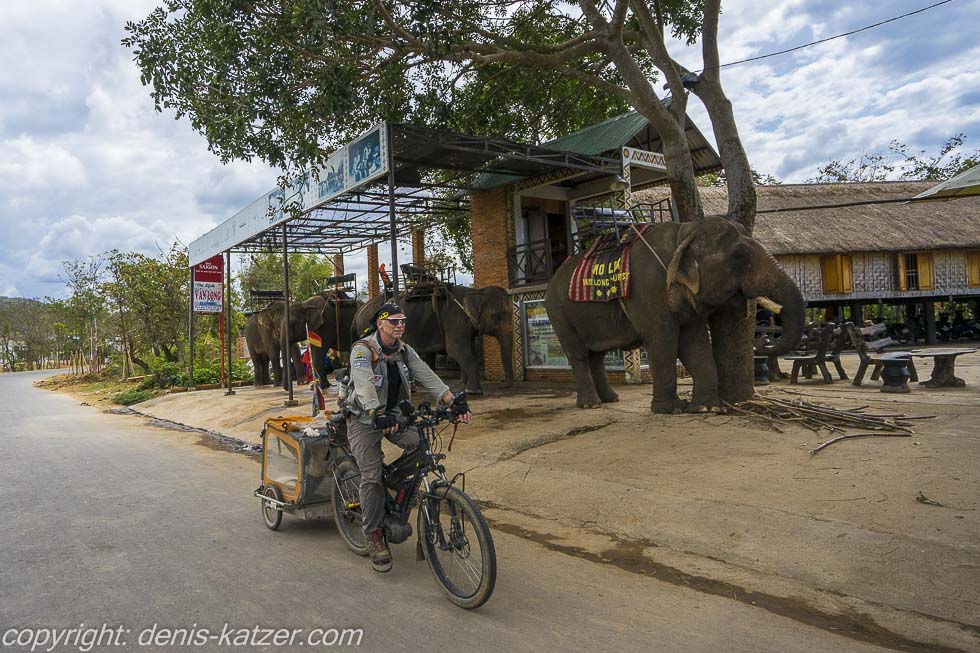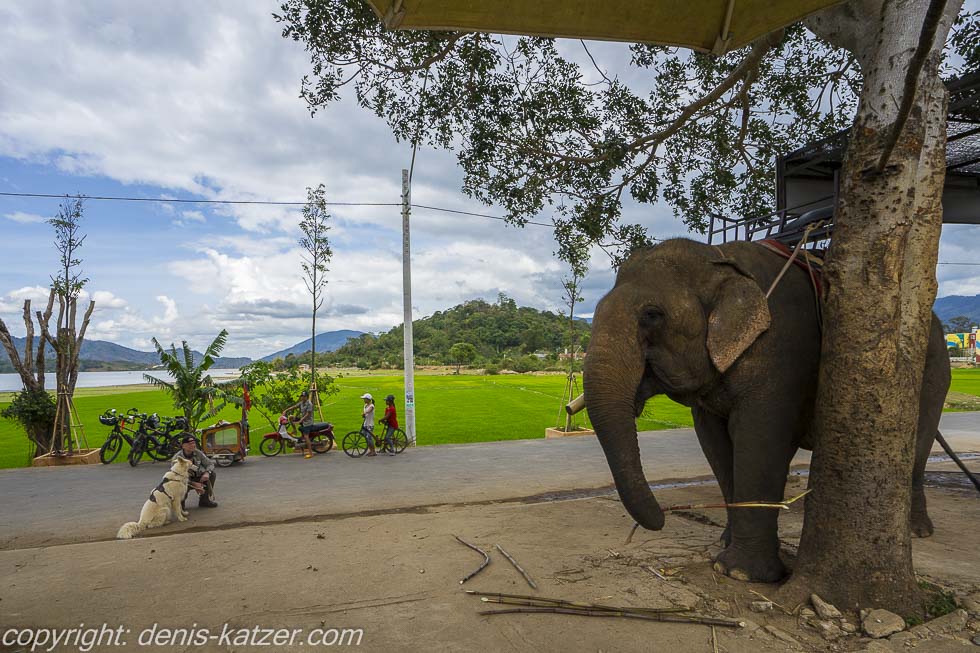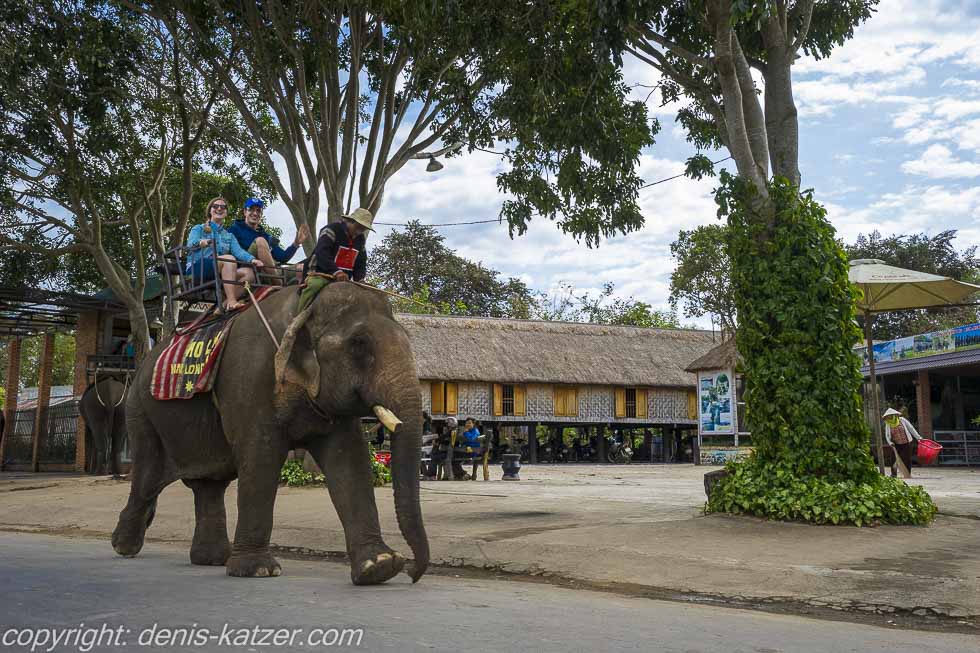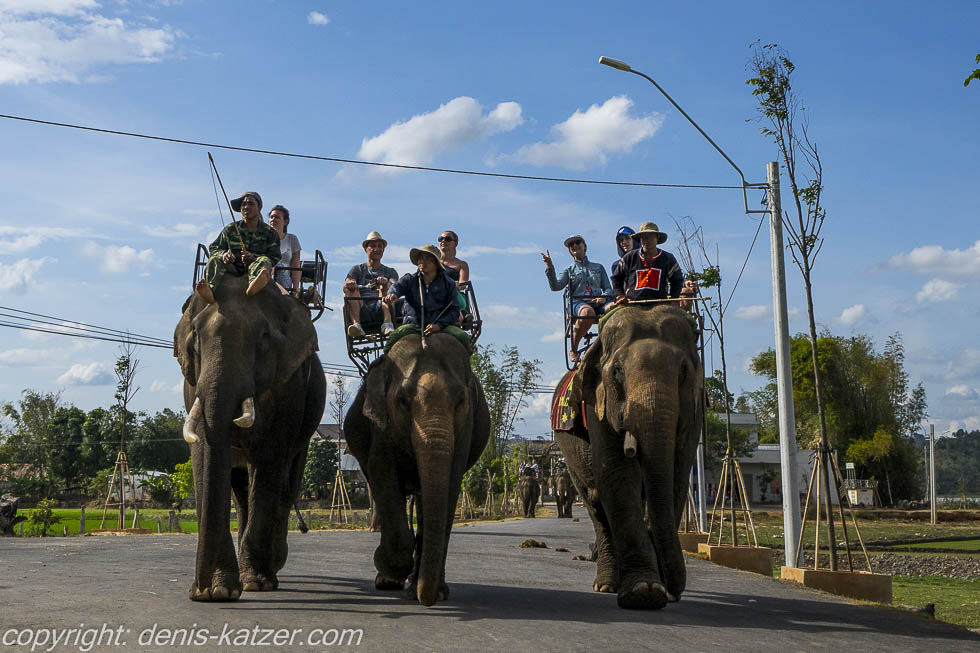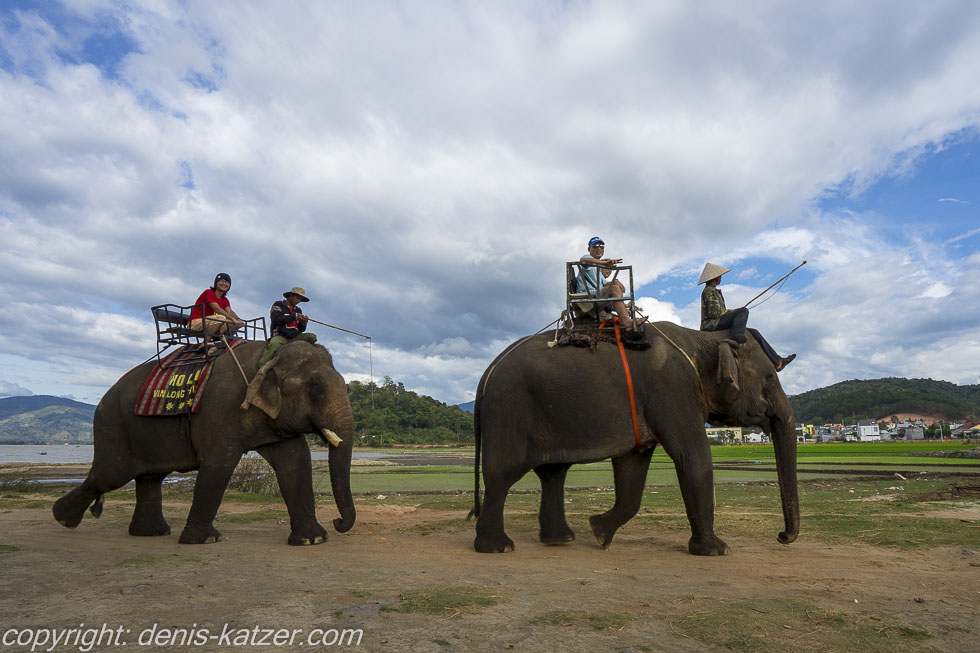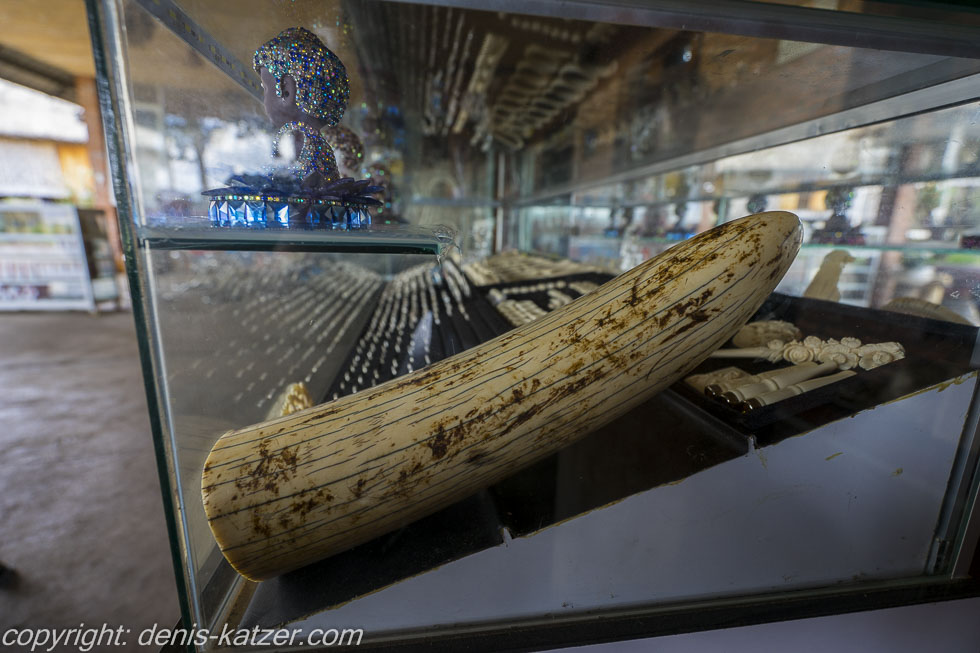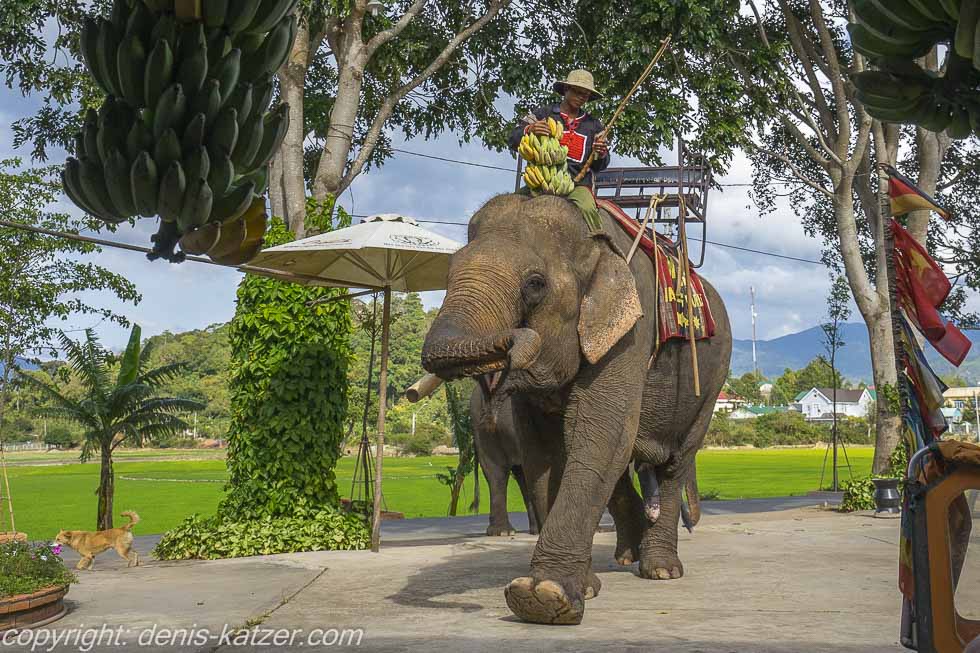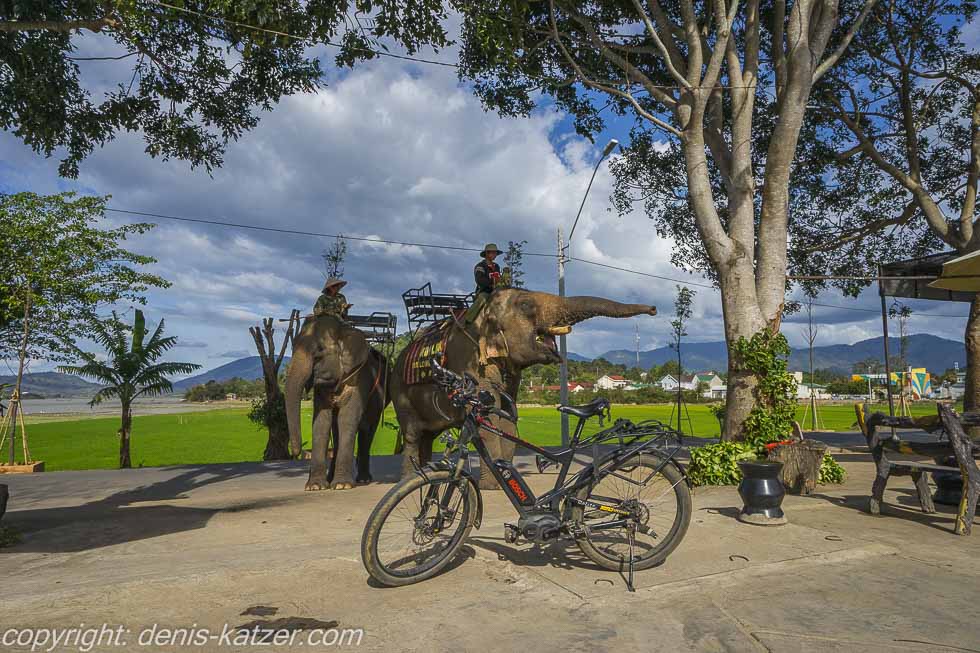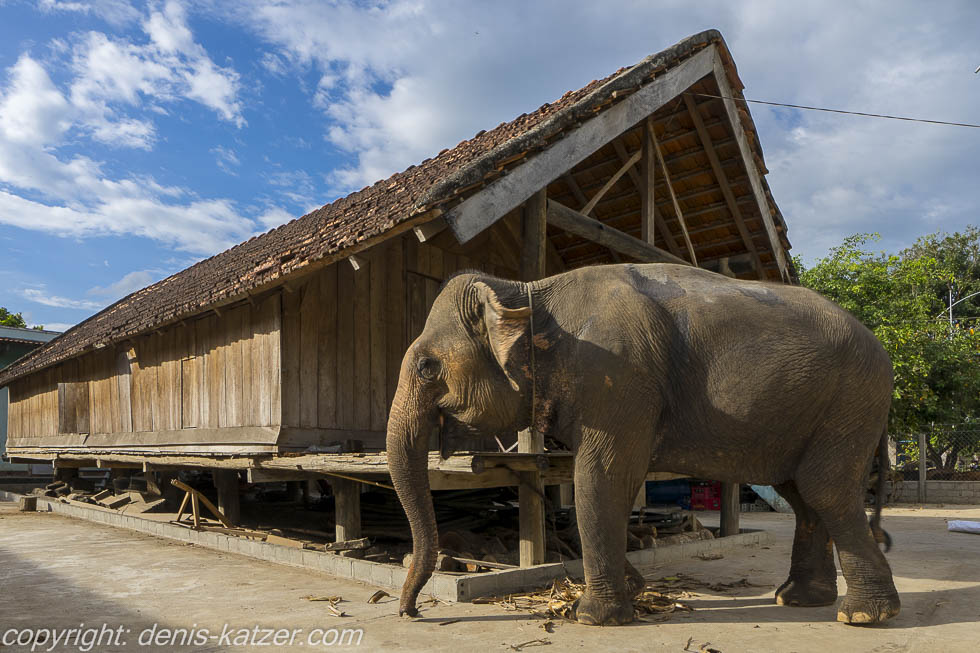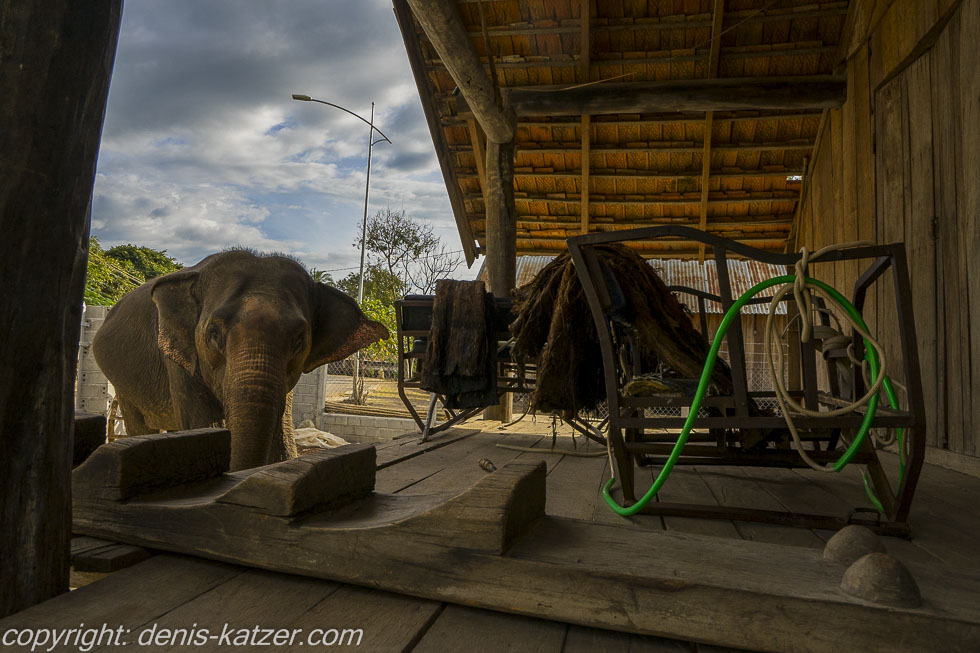
Does riding elephants make sense? – Ivory trade and conversation with the mahout
N 12°24'43.9'' E 108°10'59.1''
Date:
21.02.2017 until 23.02.2017
Day: 602 – 604
Country:
Vietnam
Province:
Đắk Lắk
Location:
Lien Son
Latitude N:
12°24’43.9”
Longitude E:
108°10’59.1”
Total kilometers:
22,323 km
Soil condition:
Asphalt
Total altitude meters:
65.000 m
Sunrise:
06:07 a.m. – 06:06 a.m.
Sunset:
5:54 pm – 5:55 pm
Temperature day max:
28°C
(Photos of the diary entry can be found at the end of the text).
To see elephants, we hop on our bikes and ride to the other side of the lake. We are back at the hostel, which was fully booked on the first day. Around 20 to 30 tourists are sitting in the restaurant below the guest rooms, waiting for their elephant trip. Only now do we realize how lucky we were not to have found accommodation here, because it is noisy and looks like a transit point for tourists constantly arriving and departing from all over the world. “Well, once again you can see how an initially thought disadvantage can turn into an advantage,” I say, pointing at the waiting elephant riders. “You’re right about that. In the meantime, I like it in the ‘the-horror-has-a-name’. The soon to be wild park with its numerous plants and blooming flowers makes it beautiful,” Tanja replies. “And above all because it’s absolutely quiet due to the small number of guests.” “Well, it might be a bit uncomfortable without my mosquito hunter,” laughs Tanja.
Five riding elephants stand in the shade of some trees. Because Ajaci has never seen elephants up close before, we go to them and take a few pictures. Warned by our experience with the aggressive elephant, we keep a safe distance. “I can’t believe it, there he is,” I say, startled. “Who?” asks Tanja, frowning. “Well, the elephant that attacked me a few days ago,” I say, pointing at the animal. “How do you know it was this particular elephant?” “It’s clearly recognizable by its right tusk. It has a notch in it. Can you see it?” “Indeed I do. The things you spot.” “His attack and appearance are unforgettable,” I explain.
The tourists climb a staircase into a small house that is open to the front. From there it is easy for them to climb into the hauda, the elephant’s saddle. The first pachyderm sets off to the loud shrieks of two Russian women. The mahout crouches on the neck of the mighty animal and drives it with commands and his feet. We stand there with an ambivalent feeling and watch the tourists’ joy. We have heard time and again that elephants are now also being trained for tourist rides and that it is not just disused working elephants that are misused for this job. Some reports document that the pachyderms are terribly mistreated during their training. During my research, I watched videos published on the networks. Although I have seen a lot in my life, the pictures are shocking and made me cry. Here is the link to two of the videos:
http://www.peta.de/thailandelefanten#.WL5drHaNDMU
http://www.peta.de/elefantenreiten#.WL5hm3aNDMV
We don’t know what the situation is like here in Vietnam, so we don’t want to pass judgment. The fact is that until recently, elephants were used for logging in the forests of Asia. This is still the case in Myanmar, for example. There, around 4,500 pachyderms drag precious tropical timber, which no excavator can reach, out of the primeval forests. The timber industry, run with the help of elephants, is still big business.
“I look skeptically after the elephants as they walk under the power cables hanging over the slope. It was actually my personal childhood dream to live with an elephant for a while, ride it and become its friend. When we spent weeks crossing the Nepalese lowlands on an elephant many years ago, the dream did not come true. Our elephant cow Bawan Kumari turned out to be extremely dangerous, as she tried to take one of our lives several times. When we asked why Bawan Kumari is so aggressive towards humans, we learned that she had already killed three of her mahouts. So she was a man-killer. Certainly a result of the cruel training of their owners, at least that’s what I’m convinced of today. We had to wait many years for another opportunity to fulfill my childhood dream after all. And now that we have reached Southeast Asia again with our bikes, the realization is within reach. Actually, but with the knowledge I have now, I wonder whether it really makes sense to ride an elephant across the country? Whether he enjoys it is doubtful. Very doubtful. And since I am an animal lover, I would not be happy to ride a creature that had to suffer terribly for it. In this case, the joy would only be on the rider’s side. A conflict is arising that is crying out for a solution. Should we rethink our elephant expedition? Yes, a very clear yes. It simply makes no sense to live out your dreams at the expense of another creature, no matter which one. So another solution has to be found. Tanja and I have been talking about it a lot recently. One of the ideas is to visit some elephant reserves to see what work can best serve these large animals, i.e. help to end their ongoing suffering. What can be done to halt the extreme decline in the overall population of the Asian elephant. The numbers alone are highly alarming, as it is estimated that a hundred years ago there were around one hundred thousand pachyderms in Thailand alone. Today, there are only between 30,000 and 50,000 left in Asia, many of whom live their lives in appalling conditions.
Above all, the question arises as to what alternatives there are for discarded working elephants, apart from carrying noisy tourists on their backs? Above all, what will happen to 4,500 Burmese working elephants who will almost certainly no longer have a job in the foreseeable future because there is no more jungle to clear? There is already an illegal trade between Burma and Thailand run by the elephant mafia. It is reported that a two- to three-year-old baby elephant is delivered to interested parties for 120 to 140 euros. According to the unscrupulous smugglers, they also procure full-grown bulls. There are hardly any problems, as there are supposedly still about. 10,000 elephants live in Burma, they are supposed to provide supplies. According to research by the renowned activist Karl Ammann, around 250 elephants have already come from Burma to Thailand in recent years, mainly so that tourists can ride the animals for half an hour, dance to disco music or provide general amusement at a resort. It is certainly not a desirable situation as an elephant to drag trees out of the jungle for decades, but it is definitely a nightmare to end up as a source of money for hotels and tour operators in noisy tourist centers or perhaps even to have to wander through noisy and polluted Asian capitals as a begging elephant to earn money for the mahout.
“The big bull there only has one tusk left,” I realize. “That’s right, you only see it when you look at it from the other side,” says Tanja. “Maybe it’s not right and completely absurd, but with the crazy price of ivory, couldn’t it be that they just sawed off one of his teeth?” I think aloud. “Oh no. Nobody does that.” “People will do almost anything for money. Some even murder or start wars for it,” I reply. “Denis, you’ve got ideas.” “I don’t think they’re that far-fetched. Look, there are display cases in the restaurant where you can buy ivory.” “That’s right. The tourists ride the animals and end up buying a piece of their tusk as a souvenir. It’s a weird world.” “And there’s also a piece of a tusk about 30 cm long in there. They probably buy that too. I’ll go and ask them what they want for it,” I decide. Standing in front of the glass case, I look at numerous bracelets, necklaces and rings made of pure ivory and the piece of tusk I have just seen. “How much does it cost?” I ask the sales clerk. “1,709,547,847 dong,” she says. “How much?” I ask as I don’t understand this enormous number. “US$ 75,000,” she repeats the figure, this time converted into dollars. “US$ 75,000 for a piece of tusk that’s maybe 30 cm long?” I ask, puzzled. “Yes sir, US$ 75,000,” she confirms. Since the average income of a Vietnamese person, which has grown considerably in the meantime, is said to have reached €157 per month, this showcase contains 40 years of labor of a Vietnamese person who has a good job. “So, with that amount of money, a mahout might be tempted to have a tooth removed from his elephant, right? Above all, that’s only a small piece in the display case. I think if it’s a whole tusk, it could be worth between 5 and 8 times as much, depending on its size. That means US$ 375,000 to US$ 600,000 for a tusk. That would be the salary of 299 to 318 years of work. Even if the procurer of ivory only gets a fraction of that, you can understand why ivory makes businessmen and corrupt politicians multi-millionaires and why African elephants are now highly endangered,” I say. We sit there thunderstruck and let the figures run through our heads. “Somehow I can’t really imagine your bill,” says Tanja after a few minutes of silence. “Well, I just extrapolated the price of the piece of ivory in the display case here. That is of course the usurious end user price, but I have read that a kg of carved ivory in China fetches prices of up to US$ 7,000, whereas the local poacher only gets about US$ 20 for a kg of raw ivory. of raw ivory. It is a business with minimal risks and maximum returns, only surpassed by the profit margins in drug and human trafficking. But similarly well organized. “Hm, and how heavy is a tusk like that?” “That depends on the size and age of the animal, of course. According to my research, the weight varies between 10 and 50 kg. So if we assume an old animal, two tusks can weigh 100 kg. The heaviest pair of tusks recorded to date is said to have weighed 190 kg. But if we assume that the average old bull weighs 50 kg per tooth, then its two tusks are worth 700,000 US dollars in their refined state.” “Unbelievable.” “With these figures, our elephants are not in the best position to survive the next 50 years.”
However. With the current background knowledge, we look at riding elephants from a completely new perspective for me. We cycle after the pachyderms with the bipeds on their backs to take a few photos. After about 15 to 20 minutes, the last lap for today is completed. Each tourist pays 750,000 dong (€30) for this. In the early evening, the mahouts bid farewell to their paying guests and ride off with their impressive pachyderms. “Where do you think they’re going now?” asks Tanja. “Come on, let’s just follow,” I suggest, and we start pedaling our e-bikes. This is how two Europeans on e-bikes end up following full-grown elephants through the dusty alleyways of a village. The first mahout steers his large animal into a small courtyard and parks it in front of a wooden hut. We stop and put our bikes on the stand. As soon as the elephant handler has tied his animal to a beam of the house with a thin chain on its front leg, he lifts off his heavy hauda and brings it plenty of bananas and sugar cane. Of course, we can’t make any judgments based on our brief observations, but it looks like the man loves his elephant. In the last warm, golden rays of sunshine of the day, we watch the harmonious scene for a while longer. Then we cycle on, perhaps to watch one of the mahouts enjoying the evening togetherness with his animal.
Just 500 meters further on, the grey skin of an elephant peeks through a green hedge. “There’s another one!” I shout delightedly. The mahout gives us a friendly wave and comes over to greet us and Ajaci. Unfortunately, we can barely make ourselves understood until a tour guide strolls down the street and joins us. “If you want, I can help you translate.” “The gods sent you. It would be fantastic if you could translate a few questions for us,” I say. “Sure, I’d love to”, he offers again, whereupon I ask the mahout if he belongs to the M’Nong ethnic group. “I suppose you know your way around?” “Not really, but it’s well known that you’ve been catching and training wild elephants for generations,” I reply. “Ha, ha, ha, we’re not allowed to catch them anymore. It’s now forbidden and only happens rarely. Apart from that, there are hardly any wild elephants left in Vietnam.” “Did you still hunt elephants yourself?” I ask the young man. “No, but my father did. Some of us did. One of us was even very successful at elephant hunting, so we called him the king of elephant hunting. He caught hundreds of elephants. His name was N’Thu Knul. He even gave the King of Thailand a white elephant.” “When did this man live?” “I don’t know exactly. As far as I remember, he was born around 1820. “And how did your father catch elephants?” I’m interested. “He and his relatives and friends always used four, sometimes even six of our trained elephants. It was always a group of at least eight to twelve.” “Did they catch really big bulls then? That must have been an incredibly dangerous job?” “It was always dangerous. You’re right about that. If something went wrong, sometimes one of them was injured or even died. But they didn’t catch big bulls. They’re far too difficult to train. The best age for a future working elephant is about four years old, because a calf drinks its mother’s milk for four years. They are easy to tame at that age.” “Must have been a tough time for such a small wild elephant?” “Ha, ha, ha. How to take it. There are various methods to make them docile. They have to learn to listen to humans early on.” “Has it ever happened that a youngster died in the process?” “As far as I know, yes, it has happened.” “How long did it take to train them like that?” “Maybe six to eight months. Some of them took longer. Sometimes over a year. But you have to know that an elephant is of immense value to us. I finance my family’s life with our elephant. He is our family member. An important part of us. In some of our villages, we even organize rituals for our elephants during the rainy season. We give thanks for the fertility of our earth. So that our elephants can eat their fill. During these months, we also think about the dry season and hope that our elephants will still have enough to eat. Fortunately, the tourists come to us. By taking elephant rides, I can feed him and us. Our elephant is healthy and strong and I am happy to see him every morning. The problem for our elephants is that the habitats are getting smaller and smaller. There are simply too many people. That is the reason why we have fewer and fewer of them. My authority and the people in our province of Đắk Lắk have done a lot to protect the elephants and increase their population again. Our Department of Agriculture started a project a few years ago to conserve and protect wild elephants in our Yorkdon National Park. It has cost many millions of dollars. People need to understand that our elephants are an important cultural treasure for us. Elephants are closely linked to our lives, are a symbol of our way of life and cultural past. A long time ago, our war elephants even put the Chinese to flight and won an important battle.”
“You have a beautiful dog. And how white he is,” says the young mahout’s mother, who has just come out of the house to greet us. “Yes, his name is Ajaci and he has traveled all the way from Germany to Vietnam,” explains Tanja. “By plane?” “No, by train and bicycle,” answers Tanja. “I hope he’s had enough to eat today?” she asks with a smile. “But yes, you can see how well-fed he is,” Tanja replies, stroking him. I say goodbye and thank the mahout. We shake each other’s hands. Then we get back in the saddle to ride to our horror-has-a-name accommodation…
If you would like to find out more about our adventures, you can find our books under this link.
The live coverage is supported by the companies Gesat GmbH: www.gesat.com and roda computer GmbH http://roda-computer.com/ The satellite telephone Explorer 300 from Gesat and the rugged notebook Pegasus RP9 from Roda are the pillars of the transmission. Pegasus RP9 from Roda are the pillars of the transmission.
